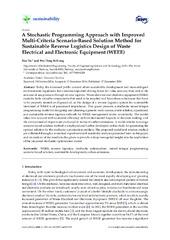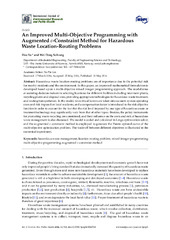| dc.contributor.advisor | Solvang, Wei Deng | |
| dc.contributor.author | Yu, Hao | |
| dc.date.accessioned | 2019-02-21T10:10:40Z | |
| dc.date.available | 2019-02-21T10:10:40Z | |
| dc.date.issued | 2018-11-29 | |
| dc.description.abstract | With the increased focus on sustainable development and circular economy, as never before, the value recovery and re-creation from the End-of-Use and End-of-Life products has been paid considerable attention by the whole society. Reverse logistics is believed as one of the most effective and promising means for the value recovery of the End-of-Use and End-of-Life products, which is the process for value re-creation through a series of activities, i.e., reuse, repair, remanufacturing, recycling and energy recovery. An extensive effort has been spent on both theoretical development and practical applications in reverse logistics during the past three decades. Today, an increasing number of companies have adopted reverse logistics in their daily business due to the pressure from the environmental conscious consumers and more stringent environmental regulations enacted.
However, due to the stochastic reverse product flow, unstable quality, the changing costs for facility operation and transportation, as well as the price fluctuation of the recovered products and energy, the design of a reverse logistics network is much more complicated in comparison with that of a conventional forward supply chain. In addition, an improperly designed reverse logistics system may incur an increased cost on facility operation and transportation, while, at the same time, has significant environmental impacts and pose a potential risk on the local residents. Therefore, it is of paramount importance to develop advanced optimization models and methods for providing decision-makers and practitioners with better support and implication for the planning of a sustainable reverse logistics system. The contemporary optimization models and methods in this field mainly focus on the economic benefits from the reverse logistics activities; however, the environmental and social sustainability of reverse logistics is rarely accounted. Furthermore, the majority of the models are developed under deterministic environmental without proper management of the market fluctuation as well as other uncertainties. Therefore, this PhD project aims to remedy the problems of the existing optimization models in order to improve the decision-making of reverse logistics network design and optimization with the consideration of environmental issues and uncertainty.
The results have contributed to the literature of sustainable reverse logistics network design in several aspects: 1. Development of the improved optimization models for balancing the trade-off between economic benefits and environmental impact of reverse logistics activities.
2. Incorporating different objective functions, constraints and elements in the modelling in order to test the effectiveness of different operational strategies, network structures and policy mechanisms.
3. Incorporating system flexibility in the modelling of a multi-product sustainable reverse logistics network in order to manage the impact from uncertainties.
4. Improvement on the solution methods for the complex decision-making problems with multiple objective functions and under an uncertain environment.
5. Gaining in-depth managerial implications for the decision-makers, supply chain managers and practitioners through the analysis and comparative study of the results obtained from the experiments. | en_US |
| dc.description.doctoraltype | ph.d. | en_US |
| dc.description.popularabstract | With the increased focus on environmental pollution and sustainable development, the value recovery and re-creation from the End-of-Use and End-of-Life products has been given considerable attention by the whole society. Reverse logistics is the process for recovering the value from End-of-Use and End-of-Life products through a series of activities, i.e., reuse, repair, remanufacturing, recycling and energy recovery. Nevertheless, due to the stochastic reverse product flow, unstable quality, the changing costs for facility operation and transportation, as well as the price fluctuation of the recovered products, the design of a reverse logistics network is a complex decision-making problem. In this PhD project, advanced optimization models and methods have been developed for providing decision-makers, supply chain managers and practitioners with better support and implications for the planning of a sustainable reverse logistics system under an uncertain environment. Moreover, the development on the modelling and solution techniques has contributed to the knowledge accumulation in operational research and management science and can also be used for modelling and resolving optimization problems in some other fields | en_US |
| dc.identifier.uri | https://hdl.handle.net/10037/14737 | |
| dc.language.iso | eng | en_US |
| dc.publisher | UiT Norges arktiske universitet | en_US |
| dc.publisher | UiT The Arctic University of Norway | en_US |
| dc.relation.haspart | <p>This thesis is based on the following papers:
<p>Paper I: Yu, H. & Solvang, W.D. (2016). A general reverse logistics network design model for product reuse and recycling with environmental considerations. <i>International Journal of Advanced Manufacturing Technology, 87</i>(9), 2693-2711. Publisher’s version not available in Munin due to publisher’s restrictions. Available at <a href=https://doi.org/10.1007/s00170-016-8612-6>https://doi.org/10.1007/s00170-016-8612-6</a>. Accepted manuscript version available at <a href= http://hdl.handle.net/10037/10508> http://hdl.handle.net/10037/10508</a>.
<p>Paper II: Yu, H. & Solvang, W.D. (2018). Incorporating flexible capacity in the planning of a multi-product multi-echelon sustainable reverse logistics network under uncertainty. <i>Journal of Cleaner Production, 198</i>, 285-303. Available in thesis introduction. Published version available at <a href=https://doi.org/10.1016/j.jclepro.2018.07.019>https://doi.org/10.1016/j.jclepro.2018.07.019</a>. Accepted manuscript version available at <a href=http://hdl.handle.net/10037/14691>http://hdl.handle.net/10037/14691</a>.
<p>Paper III: Yu, H. & Solvang, W.D. (2016). A Stochastic Programming Approach with Improved Multi-Criteria Scenario-Based Solution Method for Sustainable Reverse Logistics Design of Waste Electrical and Electronic Equipment (WEEE). <i>Sustainability 8</i>(12), 1331. Also available at <a href=http://hdl.handle.net/10037/10266>http://hdl.handle.net/10037/10266</a>.
<p>Paper IV: Yu, H. & Solvang, W.D. (2017). A Carbon-Constrained Stochastic Optimization Model with Augmented Multi-Criteria Scenario-Based Risk-Averse Solution for Reverse Logistics Network Design under Uncertainty. <i>Journal of Cleaner Production 164</i>, 1248-1267. Available in thesis introduction. Published version available at <a href= https://doi.org/10.1016/j.jclepro.2017.07.066>https://doi.org/10.1016/j.jclepro.2017.07.066</a>. Accepted manuscript version available at <a href=http://hdl.handle.net/10037/12005>http://hdl.handle.net/10037/12005</a>.
<p>Paper V: Yu, H. & Solvang, W.D. (2017). A multi-objective location-allocation optimization for sustainable management of municipal solid waste. <i>Environment Systems and Decisions, 37</i>(3), 289-308. Publisher’s version not available in Munin due to publisher’s restrictions. Available at <a href= http://doi.org/10.1007/s10669-017-9632-y>http://doi.org/10.1007/s10669-017-9632-y</a>. Accepted manuscript version available at <a href= http://hdl.handle.net/10037/12230> http://hdl.handle.net/10037/12230</a>.
<p>Paper VI: Yu, H. & Solvang, W.D. (2016). An improved multi-objective programming with augmented ε-constraint method for hazardous waste location-routing problem. <i>International Journal of Environmental Research and Public Health, 13</i>(6), 548. Also available at <a href=http://hdl.handle.net/10037/10267>http://hdl.handle.net/10037/10267</a>. | en_US |
| dc.rights.accessRights | openAccess | en_US |
| dc.rights.holder | Copyright 2018 The Author(s) | |
| dc.subject.courseID | DOKTOR-008 | |
| dc.subject | VDP::Technology: 500::Industrial and product design: 640 | en_US |
| dc.subject | VDP::Teknologi: 500::Industri- og produktdesign: 640 | en_US |
| dc.title | Optimization models and methods for sustainable reverse logistics network design | en_US |
| dc.type | Doctoral thesis | en_US |
| dc.type | Doktorgradsavhandling | en_US |


 English
English norsk
norsk

